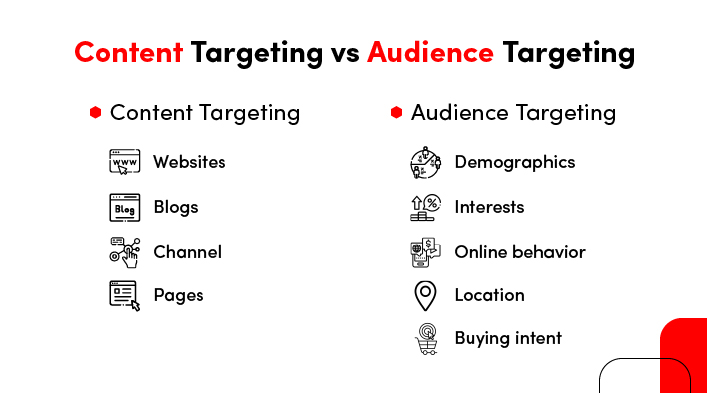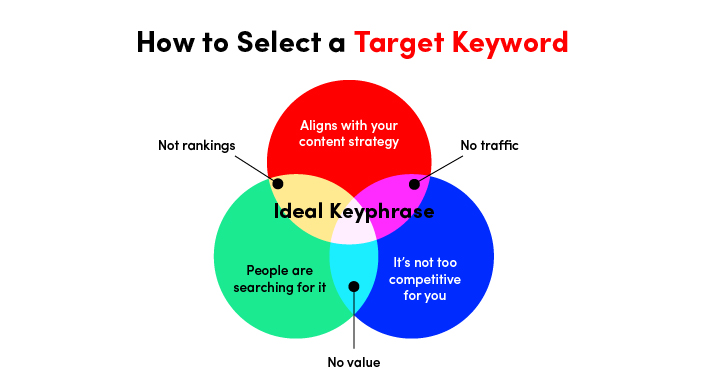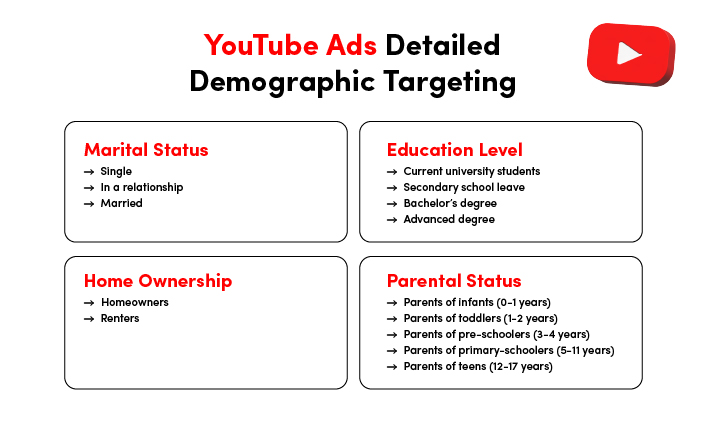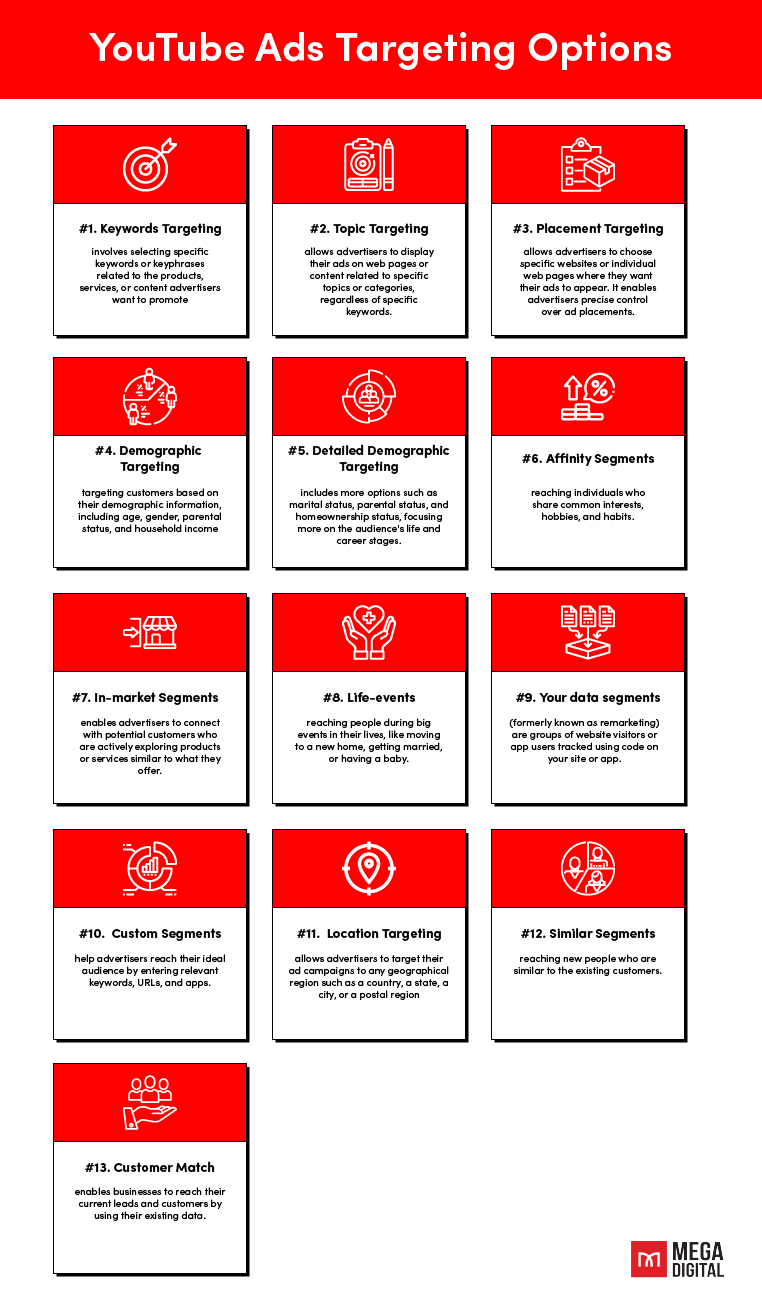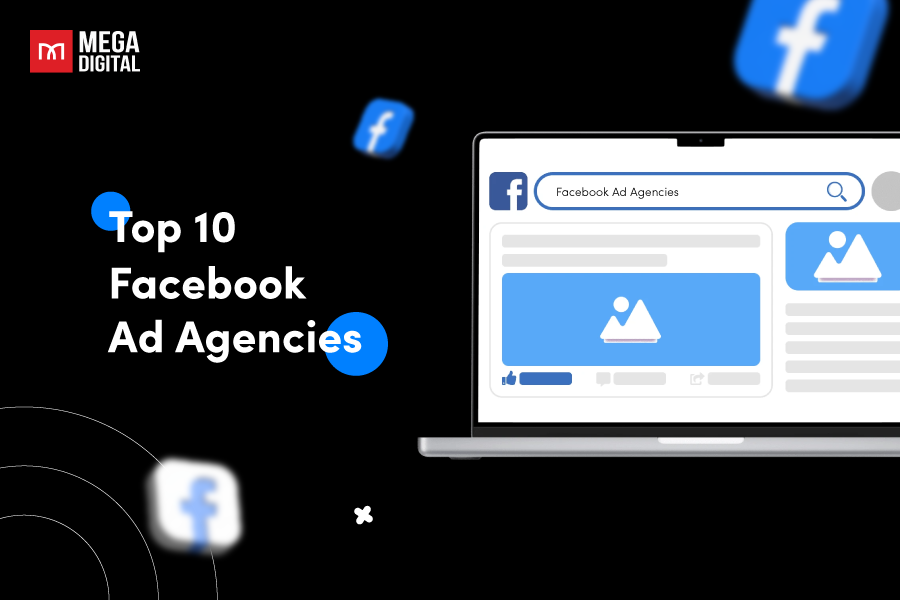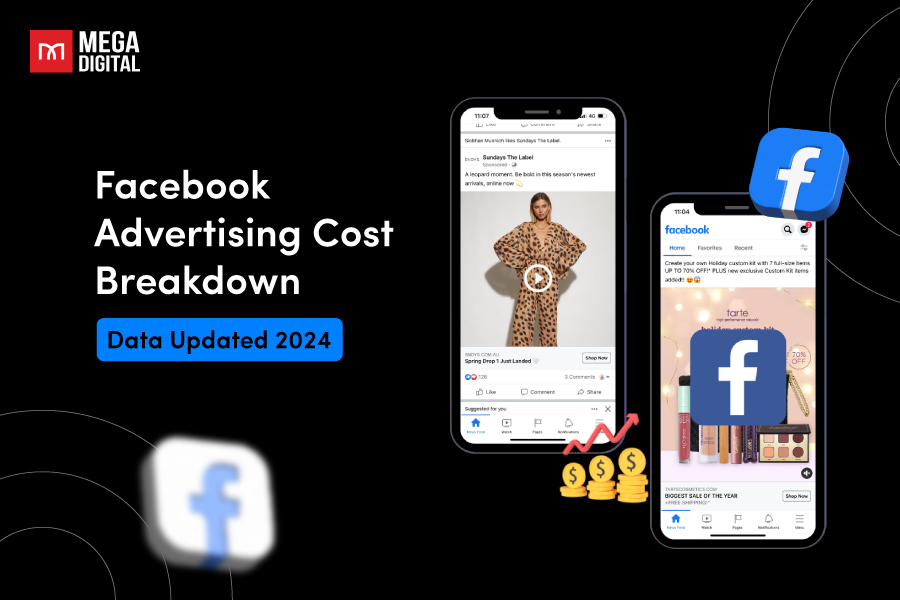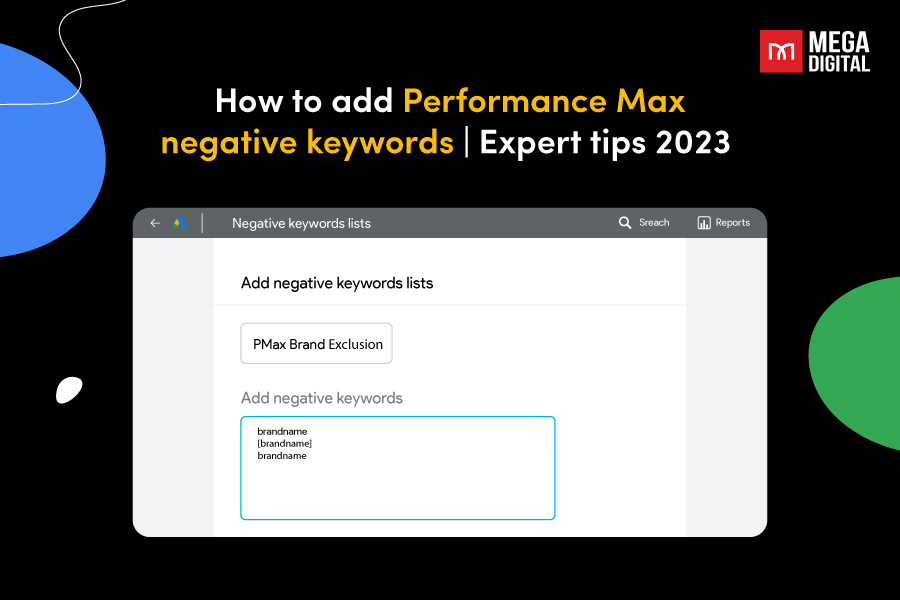There are 13 YouTube Ads targeting options, ranging from topic targeting, placement targeting,… to customer match targeting. Different options offer advertisers different ways to reach out to their target audience. In this blog, Mega Digital will break down all of these targeting options and give you some expert tips to make the right targeting choices.
- How are YouTube Ads targeted?
- 13 YouTube Ads targeting options
- #1. Keywords Targeting
- #2. Topic Targeting
- #3. Placement Targeting
- #4. Demographic Targeting
- #5. Detailed Demographic Targeting
- #6. Affinity Segment Targeting
- #7. In-market Segment Targeting
- #8. Life-events Targeting
- #9. Your Data Segment Targeting
- #10. Custom Segment Targeting
- #11. Location Targeting
- #12. Similar Segment Targeting
- #13. Customer Match Targeting
- Expert tips to choose YouTube Ads targeting options
How are YouTube Ads targeted?
Video campaigns are advertised on YouTube and various online platforms via Google Ads. By directing your Video campaigns toward YouTube and Google’s video partners, you have the opportunity to promote your content to individuals during crucial moments.
How to target YouTube Ads? Commonly, YouTube Ads targeting options can be categorized into 2 methods: Content targeting and audience targeting.
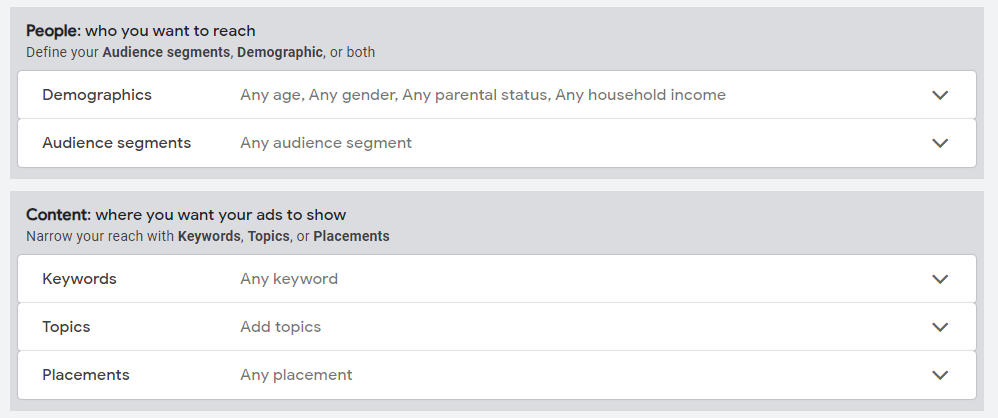
Content targeting is the practice of showing ads that match the keywords or themes of the content users are currently viewing. An example of content targeting is placing gardening supply ads on websites or web pages dedicated to gardening tips and advice.
Whereas, audience targeting is the type of targeting that categorizes consumers into groups based on various criteria, like demographics, interests, online behavior, and intent. It’s used to deliver tailored messages to the right people and prevent wasting money on uninterested individuals.
So, let’s check out 13 YouTube Ads targeting options that Mega Digital has summarized for you.
13 YouTube Ads targeting options
#1. Keywords Targeting
YouTube Ads keyword targeting involves selecting specific keywords or keyphrases related to the products, services, or content you want to promote. To put it simply, this is the type of targeting in which you choose specific words or phrases and it makes sure your ads appear when people search for those exact words.
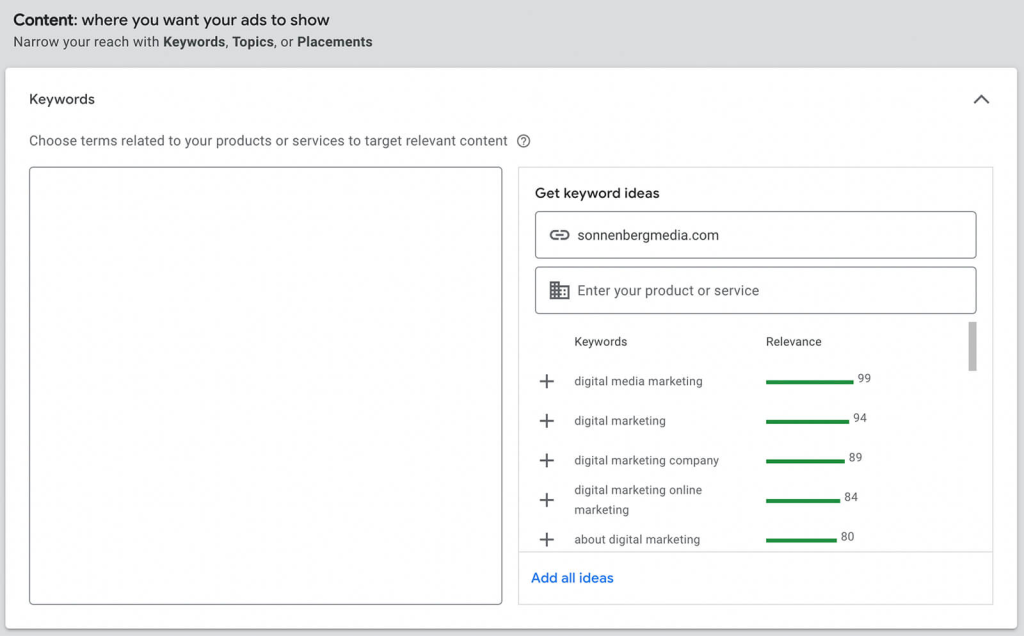
Advertisers choose keywords that are relevant to their business or campaign. For example, an online shoe store might select keywords like “running shoes”, “athletic footwear”, or “sports shoes”. Here is a tip to choose the keywords for your business.
Google Ads also provides advertisers with the opportunity to focus on keywords associated with competitors. This means you can direct your campaign towards the brand names, product or service names, and other relevant terms used by competitors. If you’re already using keyword targeting, incorporating competitor keywords into your list can expand the reach of your video campaign.
#2. Topic Targeting
Topic targeting is a feature that allows advertisers to display their ads on web pages or content related to specific topics or categories, regardless of specific keywords.
You can target both main and sub-topics. For example, when you target “the beauty and fitness” topic, you could go deeper by targeting the “fitness topic” or even deeper than that and target the topic “bodybuilding”. It depends on your campaign to decide whether to go wide or go deep.

Compared to other YouTube Ads targeting options, topic targeting can expand your reach beyond users actively searching for your products and reach to a broader audience. By making a creative and attractive ad, you can turn these users into customers, even when they haven’t searched for your products before.
#3. Placement Targeting
YouTube Ads placement targeting simply allows you to choose specific websites or individual web pages where they want their ads to appear. It enables advertisers precise control over ad placements.
For example, an interior design company may choose to place its ads on a popular interior design blog to target an audience interested in home décor. At the same time, a political campaign might decide to place its ads on a major news website to reach a broad audience.
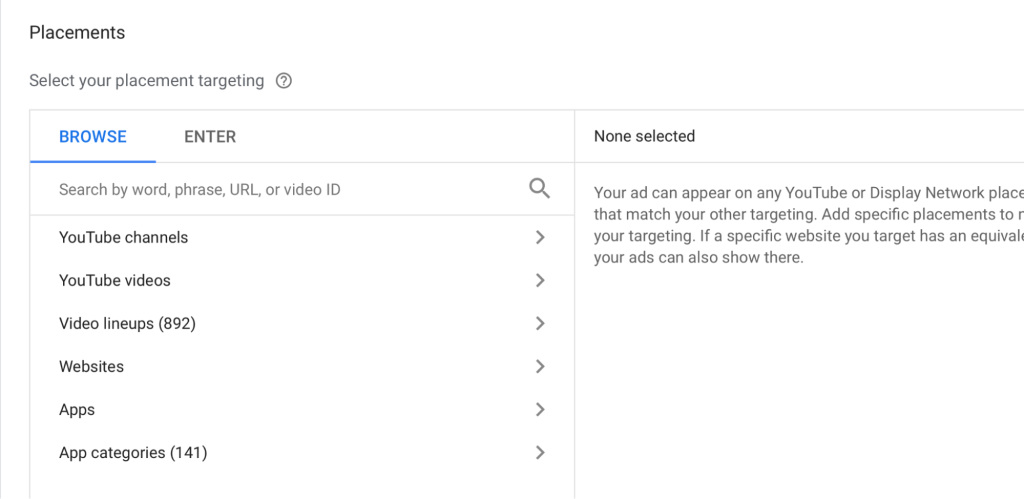
There are 3 placements where your YouTube Ads can be shown:
- YouTube search results
- YouTube videos
- Video partners on the Display Network.
In other words, your YouTube Ads can appear on many platforms beyond specific YouTube channels or videos, such as websites, apps,… as long as they belong to Google’s Display Network. It is important that you choose the most optimal placements for them for the best performance.
An interesting thing with placement targeting is that you can target your competitors’ YouTube channels by displaying your ads directly on their channel content.
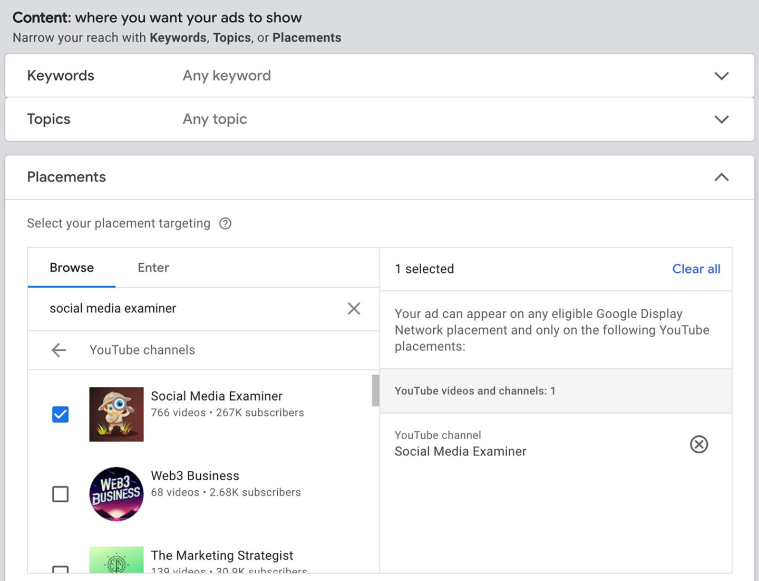
All you need to do is choose ‘YouTube Channels‘, enter competitor names, and get insights like subscriber count and video numbers to estimate reach effortlessly. Once you do, the competitor’s viewers may see your YouTube Ads videos.
Moreover, if your competitors have videos that attract a substantial number of views, you may want to explore the option of displaying your YouTube ads on those particular videos. The procedure for targeting competitor videos is identical to selecting any other YouTube video. Navigate to Placements, opt for YouTube Videos, and input the URLs of the videos you wish to target.
#4. Demographic Targeting
Demographic targeting in YouTube Ads is a form of behavioral advertising, allowing advertisers to focus on ideal customers by selecting or excluding them based on their demographic information, including age, gender, parental status, and household income.
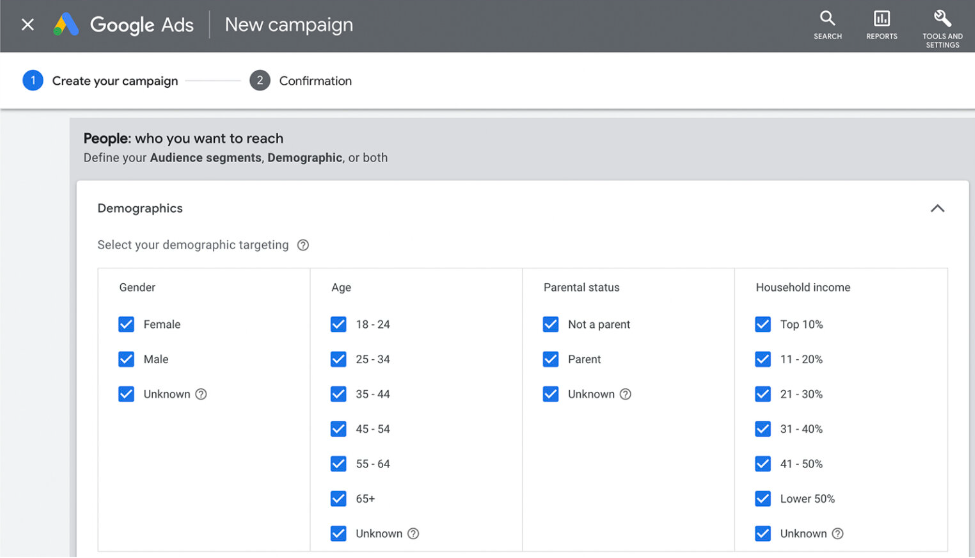
When using demographic targeting in your YouTube Ads, you have the flexibility to exclude specific groups, like children if your product is exclusively for adults. This exclusion can be applied at the campaign or ad group level.
Additionally, there’s an ‘unknown‘ category for individuals whose demographics are unclear to Google. Initially, it’s wise to exclude the ‘unknown’ category, but as your campaign gains traction, consider reintroducing it to assess its performance, especially if Google’s system becomes better at identifying your target audience.
#5. Detailed Demographic Targeting
As the name could tell, detailed demographic targeting in Google Ads goes beyond demographic targeting. It includes more options such as marital status, parental status, and homeownership status, focusing more on the audience’s life and career stages.
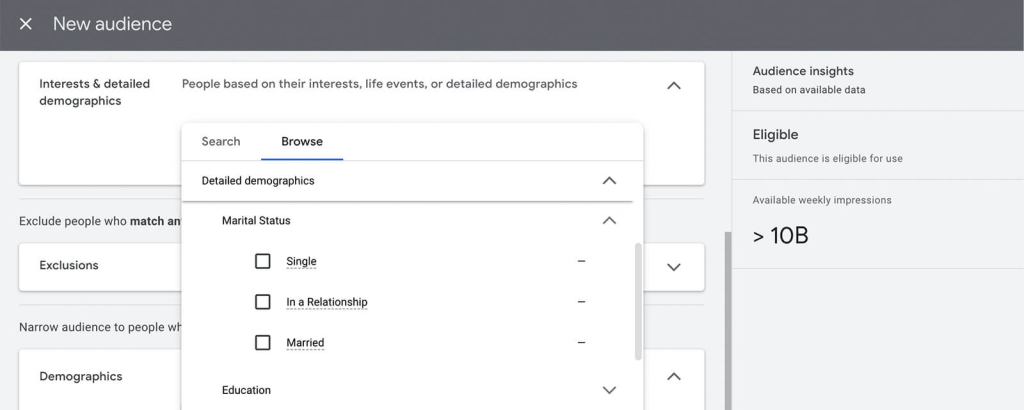
Detailed demographics, which were initially for Search campaigns, now apply to Shopping, Discovery, Video (YouTube), and Display (Gmail) campaigns. However, some categories may not be available for all campaign types. Parental status, marital status, education, and homeownership status are options for all campaigns, while Employment is exclusively for Search campaigns, including both Company size and Industry subcategories.
#6. Affinity Segment Targeting
Affinity audience targeting is all about reaching individuals who share common interests, hobbies, and habits. For example, if you run a fitness apparel brand specializing in sportswear and fitness clothing, you can aim your advertising at audiences interested in “sports enthusiasts” or “health-conscious individuals”.
This affinity targeting allows you to reach people who are already passionate about an active lifestyle and, therefore, more likely to be interested in your products.
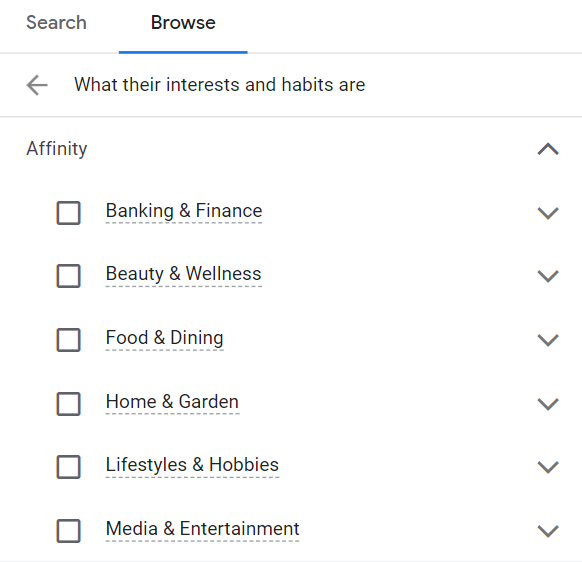
#7. In-market Segment Targeting
This targeting option enables you to connect with potential customers who are actively exploring products or services similar to what you offer.
An example of in-market audience targeting is, if you sell cameras, you can target an in-market audience of individuals currently in the market for new cameras. This way, you reach those who are genuinely interested in your product category and more likely to make a purchase.
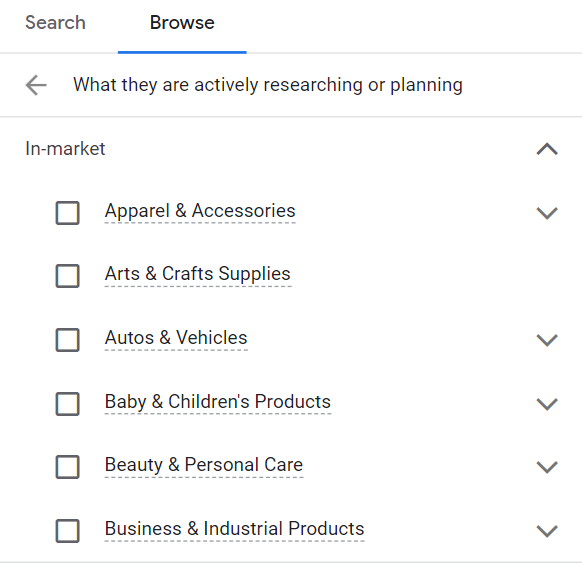
#8. Life-events Targeting
Life-event targeting allows you to reach people during big events in their lives, like moving to a new home, getting married, or having a baby. Usually, at this phase, customers have an urgent demand for a specific product and are more likely to buy yours if you reach out to them timely.
Imagine you run a home decor store, and you use life-event targeting to connect with people who’ve recently moved to a new home.
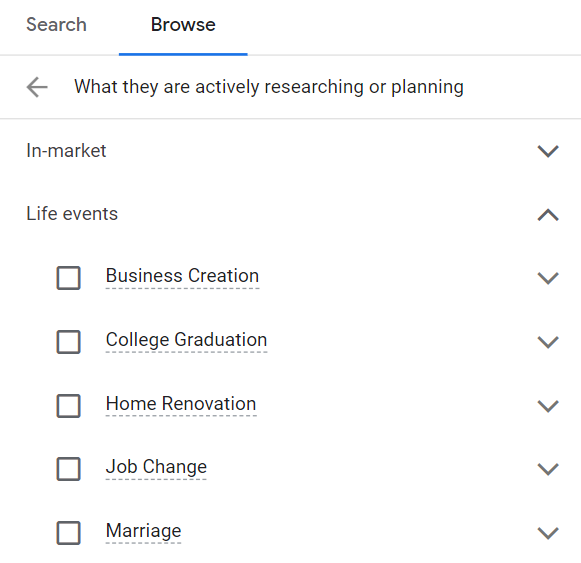
#9. Your Data Segment Targeting
Your data segments (formerly known as remarketing) are groups of website visitors or app users tracked using code on your site or app. You decide when they join the group and how long they stay there. When you create a segment, it starts empty. As people visit your site or use your app, they join based on your segment rules. So to target them effectively with your ads, add these segments to your campaigns, ensuring your messages reach the right audience.
#10. Custom Segment Targeting
With Customer Segments, Google automatically matches your customer’s data to users in its database. You can use this audience to target customers across various Google platforms like Search, YouTube, Gmail, and the Google Display Network, enhancing your advertising reach and effectiveness. There are 3 options for you to create a custom audience segment:
- The interests and products/services people are searching for
- The types of websites people browse
- The types of apps people use
Take a look at this example:
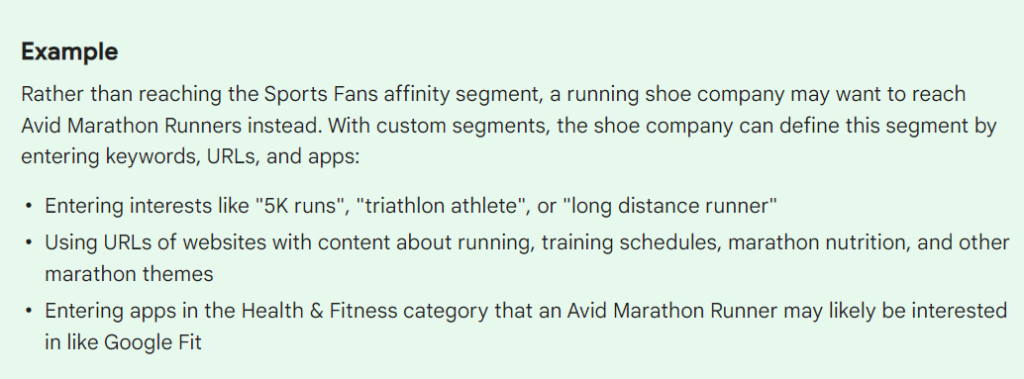
#11. Location Targeting
Geographic targeting allows you to target your ad campaigns to any geographical region such as a country, a state, a city, or a postal region.
For example, if you run a chain of local coffee shops in New York City, you can set up a YouTube Ads campaign to specifically target users in the five boroughs of New York City (Manhattan, Brooklyn, Queens, the Bronx, and Staten Island). This way, your video ads will be shown to users who are more likely to visit your coffee shops

Research reveals that a significant 80% of consumers express their interest in receiving location-based notifications from businesses and 61% of smartphone users are more likely to make purchases from websites that personalize content based on their geographical location.
>>> Read more: Google Ads Location Targeting – How to Set Up Geotargeting
#12. Similar Segment Targeting
Similar segment targeting is reaching people who are similar to your existing customers. It is like finding new friends who have the same interests as your current friends. If you have a group of customers who have purchased gardening tools, you can use similar segment targeting to show your ads to people with similar interests or online behaviors, like those who have been browsing gardening websites.
#13. Customer Match Targeting
Customer match is a remarketing strategy that enables businesses to reach their current leads and customers by utilizing their existing data. A practical example of customer match marketing is when a company uses its email list of previous customers to create customized ads and promotions for their existing customers, encouraging them to return to the website, make new purchases, or engage with special offers.
Similar segment targeting and customer match targeting are YouTube Ads targeting options requiring existing user’s data. The difference between these two is that while the customer match helps you remarket (or retarget) only to those in the list, similar audience targeting helps you reach new audiences similar to your existing customers and are most likely to convert.
So, those were the 13 most frequently used targeting options for YouTube Ads. To provide you with a clearer understanding of these choices, we’ve compiled information in an infographic.
Expert tips to choose YouTube Ads targeting options
Each audience segment and each campaign may require different ways to approach. So how should you target your YouTube Ads? Here are 2 tips Mega Digital has concluded for you after running thousand Google ads campaigns for our clients.
Understand your target audience
Who is your target audience? What are their demography, psychology, and behaviors? What are their search or buying intentions?… You have to draw an overall picture of your target audience. Only from then can you choose targeting options based on your audience’s understanding.
If you don’t know who your target audience is, you can try analyzing your customer base, market trends and competitors, or carrying out some interviews. Don’t make any subjective assumptions about your target audience, it may lead to a failure while targeting.
Choose YouTube Ads targeting options based on the customer journey
At different phases of the customer journey, the target audience will encounter different touchpoints. Your YouTube Ads have to become one of those touchpoints in order to convert the audience to the next phase until they become your buyers.
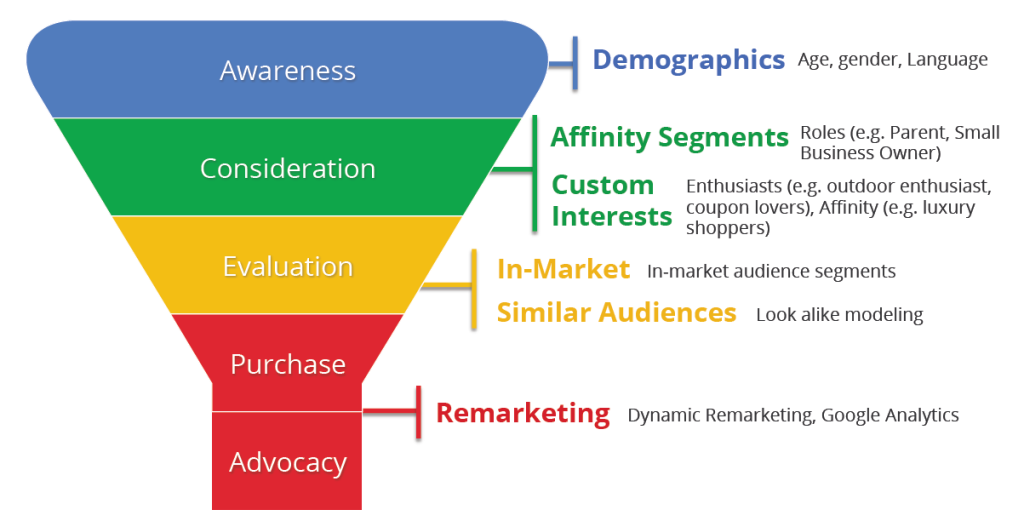
We suppose that your ad campaign is to raise awareness, you can use placement targeting to place your YouTube Ads on different channels and websites or demographic targeting, as these methods will help you reach a mass audience.
However, if your customers are considering which products to buy, they may search for reviews on YouTube and Google so you can use keyword targeting and interest-based targeting (affinity Segments and Custom Interests) to easily reach out to them. Choose targeting options based on the customer journey.
Final words
Mega Digital believes that this blog has provided valuable knowledge and insights on 13 YouTube Ads targeting options. The good thing is that the choices are all up to you. You can choose to use one of them or many of them at the same time to make sure that your YouTube Ads will appear in front of the right audience.







